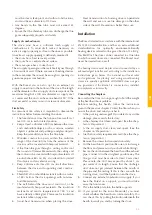
19
GB
temperatures above 400 °Celsius. This will happen
during the first few times of lighting the stove and
temperatures rise to 600 °C. Though this may give an
unpleasant smell, it is otherwise harmless. It is advisable
to keep the stove burning with limited fuel for at least 6
hours when lighting the stove for the first 4 or 5 times.
Air the room well when the stove is burning. Make sure
that any cooking hood is not turned on when the stove
is burning; a cooking hood extracts the combustion air
that the stove needs.
Some deposit may form on the glass panes of the stove
when you ‘anneal’ your hearth. You can easily remove
this deposit with a damp cloth after the stove has cooled
down. You can also use some cleansing agent for
ceramic rings. Please make sure you do not leave any
finger marks on the clean glass. Finger marks burn into
the glass and cannot be removed later.
Fuel: wood
Wood species
Drying time
Fir, Poplar
1
year
Lime, Willow, Spruce, Birch, Ash, Alder 1.5
years
Fruit trees, Beech
2
years
Oak
2.5
years
The stove only burns on wood. Do not put more than 3
to 4 kg of fuel in the stove at the time. Always use clean
and cut logs, which have sufficiently dried. Please see
the above list for drying times. Wet wood does not burn
well and gives heavy smoke emission. It may blacken the
glass pane of your stove with soot and build up smut in
the flue pipe. This may increase the risk of chimney fire.
Fresh, moist wood contains about 50% moisture.
Cleaved wood still contains 20% moisture after drying
it for a year and moisture percentage will be decreased
to 12 to 15% after drying it for two years. Dry wood
gives nice flames and little or no smoke, and the fire
will crackle when burning. Wet wood makes a hissing
sound, gives much smoke and only small flames which
will considerably dampen the pleasure of burning your
stove and the heat output.
Do not put any paraffin-containing logs in your stove.
When the door is closed, the high heat will melt the
paraffin from the logs too quickly. The polluted flue
gasses which consequently develop will deposit on and
burn in the glass of your stove and cannot be removed
later.
Do not use any wood that is painted, impregnated, glued
together or processed in any other way. The flue gases
are very harmful to the environment and may affect your
stove. It is also prohibited to burn plastics and other
waste matter due to poisonous smoke development.
The best way to burn your stove
All WANDERS’ stoves are designed so that they give a
maximum output. A well-lit wood-burning stove can
produce a yield of about 75%. This means that you need
less wood for the same amount of heat. Moreover, a
well-lit stove produces less smoke pollution. Below are
a few tips to give you optimum pleasure:
• For a regular combustion, close the grate shaker when
the stove is fuelled with wood.
• If you close the energy-saving valve during operation
you will save a considerable quantity of fuel and
increase heat output at the same time
• Always burn your stove with its door closed; this
will improve the output within 8 to 10 times. When
the door of the stove is open, the chimney will draw
more air than is needed for proper combustion. The
relatively cold air will cool the fire. It will also preclude
fire damage by any sputtering sparks, especially from
softwood.
• Do not put more than 3 logs on the fire at one time. Too
much fuel at one time thwarts efficient combustion
and burdens the environment unnecessarily.
Newly-built house or recently renovated?
It is advisable to wait six weeks before lighting
the stove in a newly-built house that has recently
been completed, or in a space that has recently
been renovated drastically. The walls and ceilings
still contain gases, softeners and moisture from
plasterwork or paint. The warm air-streams may
discolour the dust particles in the space which may
stick to walls and ceilings. Even the moisture in the
walls and ceilings will become warm and may cause
yellow stains.
Wood species and storage
You can use all kinds of woods as fuel as long as it
is clean, split and dry. Hardwood like oak, beech
and birch burn slowly, give off much heat and
form charcoal easily. Softer woods like spruce, fir
and poplar give more flames but less heat and less
charcoal.
The best place to store timber is in a windy spot but
sheltered from the rain. This is how the logs can dry
in a natural way. Pile the logs on an old pallet or a
frame to let the wood dry from underneath and to
prevent the lower logs from being in contact with
water.
Summary of Contents for Boreal
Page 14: ...14 User s Guide and Installation Manual Boreal GB...
Page 27: ...27 FR Mode d emploi et instructions d installation Boreal FR...
Page 41: ...41 D Gebrauchsanweisung und Installationsvor schriften Boreal DE...
Page 58: ...58 INK 8152 HBO 0570 INK 7041 HBO 0575 SBO 1012 HBO 0574...
Page 59: ...Technische tekeningen Technical drawings Dessins techniques Technische Zeichnungen 59...
Page 60: ......
















































